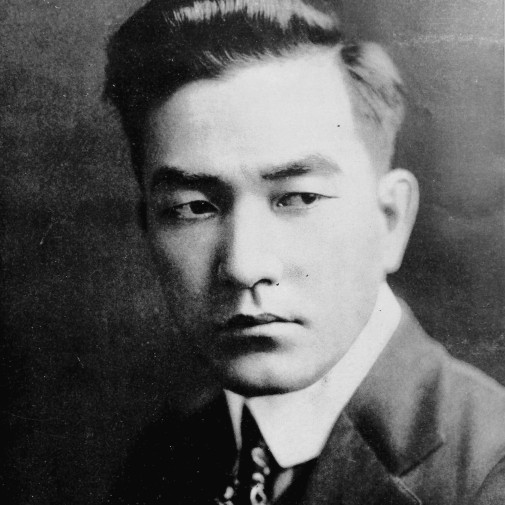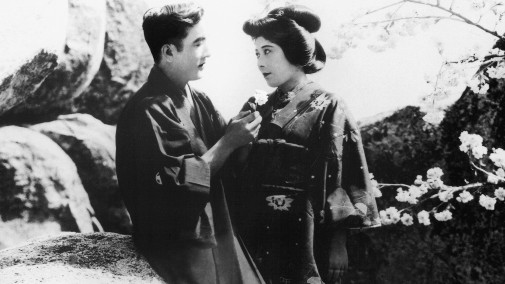Sessue Hayakawa: From sex symbol to Oscar nominee
 Saturday, July 11, 2020 at 11:00PM
Saturday, July 11, 2020 at 11:00PM We've been celebrating 1957 for a couple of weeks. Here's one more from Cláudio Alves

In 1957, Miyoshi Umeki became the first and only Asian woman to win an acting Oscar. However, the Best Supporting Actress champion wasn't the only Japanese performer to score an Academy Award nomination that year. Sessue Hayakawa, who played the ruthless Colonel Saito in the Best Picture winner The Bridge on the River Kwai, became the first male actor of Japanese descent to be nominated by the Academy. Unlike Umeki, who had less than a decade of experience in show business by the time she achieved Oscar glory, Hayakawa had a long history with Tinsel Town. Many decades before his nomination, when the American film industry was creating itself and Silent Cinema was entertainment for the masses, Sessue Hayakawa had been one of the first sex symbols…

Born Kintaro Hayakawa, the future actor was the son of a humble fisherman in the Chiba Prefecture of Japan. Initially intent on becoming a military officer in the Imperial Army, a ruptured eardrum made him abandon such ambitions and drove the young man to attempt suicide. Saved by his father but still despondent, Hayakawa left Japan and emigrated to the US. What happened next is disputed by different historians and biographers, though we do know that Sessue Hayakawa ended up performing as a stage actor in California. It was that job that got the attention of film producer Thomas H. Ince, the man many call the father of the Western. Just in 1914, Hayakawa appeared in more than a dozen Ince productions, including the smash hit The Typhoon which was quickly followed by The Wrath of the Gods in which Hayakawa acted alongside his future wife and fellow Asian-American film star Tsuro Aoki.
When watching Hayakawa's early work, it's astounding how realistic his presence and technique are. For those who believe silent movie acting was all about broad gestures and inelegant mugging, Sessue Hayakawa's performances can come off as a shock of precise naturalism. Even when covered in bad old-age make-up, like in The Wrath of the Gods, he exudes a sense of lived-in verisimilitude that makes it impossible to take the eyes away from him. That magnetism would only become more obvious in the following years when Hayakawa abandoned the productions of Thomas H. Ince and started working for Famous Players-Lasky, later renamed as Paramount Pictures. It was this new studio that produced and released the movie that made Hayakawa into a matinée idol and a pop culture sensation.

The Cheat is one of Cecil B. DeMille's best silent films, and, despite its racist ideology, it gave Hayakawa the role of a lifetime. As the perfidious Haka Arakau, the actor breathes life into an insidious villain, an ivory merchant who uses his wealth to manipulate a spoiled society woman and bend her to his will. He may be a villain, but it's difficult to resist the allure of Arakau, who Hayakawa makes sexy, even as his controlling violence becomes explicit. This strange mix of sex and threat, of romantic folly and xenophobic exoticism, was a winning combination for the American public. In our current predicament, when Hollywood rarely depicts men of Asian descent as sexual beings, it might seem weird, but one of its first true sex symbols was a Japanese actor.
Despite his success and clear sex appeal, Hayakawa's tenure as a romantic leading man was often overshadowed by the racism with which his roles were tainted. The Cheat's villain became a model for a lot of Hayakawa's future roles, which earned the actor a terrible reputation in Japan, a nation whose people were vilified by such roles. In part because of that, but also because he wanted better parts and more autonomy, Sessue Hayakawa formed his own production company, Haworth Pictures. With more creative control, the star produced movies that showed the Japanese in a positive light and gave his wife Tsuro Aoki roles that were worthy of her. Their best film made during the years of Haworth Pictures is probably The Dragon Painter, a meditative study on the artist's process, one of the best showcases for the actor's talent.

Still, we must point out that Hayakawa wasn't an all-out champion for Asian representation in American cinema. Haworth Pictures' flicks might humanize the Japanese but they made no qualms about vilifying other Asian cultures. 1919's The Tong Man, for instance, is full of Chinese stereotypes and white actors in yellowface, even though it's one of the few pictures in which Hayakawa got the girl by the story's end. No matter his morally dubious efforts to direct white supremacist hatred towards other Asian nationalities other than Japan, Hayakawa suffered a great deal from the anti-Japanese sentiments that infected Hollywood. By 1922, the leading man who could rival Chaplin and Barrymore in terms of fame left Hollywood.
Throughout the next years, Sessue Hayakawa became a world-wide phenomenon appearing on stage productions all over Europe and Japan, while also starring in other non-American film productions. Returning to the US in the late 20s, Hayakawa kept focusing his attention on the stage, but he did the occasional motion picture. For example, in 1931's Daughter of the Dragon, a movie in the Dr. Fu Manchu franchise, Hayakawa played a supporting role alongside Anna May Wong's criminal temptress. Still, it was in 1937 that Sessue Hayakawa's career took a series of unexpected turns that would forever change his life.

Trying to reconnect with his Japanese roots, Hayakawa starred in an international co-production named The Daughter of the Samurai, alongside rising star Setsuko Hara. The movie was a Nazi Propaganda piece whose nationalistic ideals are impossible to ignore, but, whatever goodwill he might have gained from the Japanese audiences was quickly lost when Hayakawa took part in Max Ophüls' Yoshiwara. That French story of sordid love triangles in the red-light district of Tokyo scandalized Japan and Hayakawa was labeled as a traitor for his participation. The animosity of his countrymen made him stay in France for a prolonged time and, in 1940, the actor was effectively trapped in Europe once the Nazis invaded. Earning his living through small acting jobs and watercolor painting, the former star of a Nazi propaganda film would become part of the French Resistance and aid in the fight against fascism.

It was thanks to Humphrey Bogart that Sessue Hayakawa put an end to his nomadic lifestyle and, at last, returned to Hollywood. Boggie's production company managed to locate Hayakawa in France and offered him the role of Baron Kimura in 1949's Tokyo Joe. The movie is a post-war noir whose themes are very similar to Casablanca, with Hayakawa's supporting character being a former head of the secret police who's turned to a life of crime. It's no masterpiece but the Japanese actor's menacing performance is impressive nonetheless, and it helped him gain a few other jobs as a Hollywood character actor for films with Japanese themes. Just the following year, he'd play a POW camp commander in the Claudette Colbert vehicle Three Came Home.

These late years of Sessue Hayakawa's screen career were dominated by authority figures whose blind loyalty to the Japanese nation often made them either monstrous or ineffectual. Because of that, it seems correct that the performance that would earn him his only Oscar nomination typifies all those elements. The Bridge on the River Kwai's Colonel Saito is a synthetization of Sessue Hayakawa's screen presence during the post-war period, a portrait of nationalistic pride folding itself into villainous folly. In that regard, he's the mirrored image of Alec Guinness' officer Nicholson, an obsessive man gone mad that earned the English thespian the Best Actor trophy of 1957. Personally, I'd have given Hayakawa the Supporting Actor prize over Red Button's romantic soldier in Sayonara.
Sessue Hayakawa's final screen performance was a voiceover work for the animated picture The Daydreamer from 1966. After that, he abandoned the craft of acting, though he still coached some aspiring performers, and dedicated most of his time to Zen Buddhism. He managed to become an ordained Zen Master before his death in 1973 at the age of 83. His life was extraordinary, full of twists and turns, vertiginous success, and the horrors inflicted by systematic racism. One wonders why a lavish biopic hasn't been yet made about Sessue Hayakawa. Supposedly, Japanese director Nagisa Oshima tried to make such a movie, but the project was never completed. It's a pity because Sessue Hayakawa deserves to be celebrated and remembered. For a Hollywood pioneer of such importance, he's been short-changed by film history and cinephiles in general. Let's rectify that and applaud one of the most talented and sexy movie stars of all-time.

While many of Hayakawa's early films have been lost, a good portion of his silent movies which survived are available, either on DVD editions or even Youtube. As for his Oscar-nominated performance in The Bridge on the River Kwai, you can rent it from Amazon, Vudu, Redbox, Google Play, and others.



Reader Comments (14)
Absolutely fascinating. Thank you!
Of his silents I'm afraid I've only seen The Dragon Painter which was a very interesting view. I'll have to look around and see what else is available. I have seen a bit more of his sound output, beside River Kwai he was very good in Three Came Home. He and Claudette had a fine spiky adversarial chemistry which fit the movie's story well.
There is one film that I've long thought he would have been perfect for-A Majority of One-instead we have Alec Guinness in yellow face. He plays the part with great feeling as does the equally oddly cast Rosalind Russell (as a Jewish widow-the part calls out for Thelma Ritter) so that it's not a horror show but I've wondered why he wasn't cast since by the time it was made (1961) he was widely respected and a name performer. Oh well such are the vagaries of Hollywood.
Thank you Claudio! This was brilliant. I also can't understand why they haven't made a film about him. There are many bankable , handsome Asian actors now that could play him. His life was fascinating!
So that's what he looked like much younger. What a beautiful man.
I know it's a shallow comment, but boy, was he gorgeous.
I wonder if he's well enough known in Japan to get the bio treatment? His story would be fascinating, but to do it right would cost a pretty penny.
Dave in Hollywood: I dont think that whether he is well-know in Japan would be a deciding factor. I'm talking a US production. Japan is not going to be the main market. Just look at Memoirs of a Geisha. Maybe even a 2- or 3-part miniseries would do.
Really interesting reading. This is the kind of articles i wish were more often in this page.
Such an interesting read! More and more I look forward to your content Claudio.
His work in Three Came Home is a favourite of mine. I think he should have picked up a supporting nomination for it. He brings dimension to the character of Colonel Suga. It was a tricky role given the film's release only a few years after the end of the war.
This is a quality article.
He surprised me as an exception because his face has a wide range of expressions, especially in silents. He’s one of the good ones.
That was fascinating and great to learn about his career. It puts his nomination in context too, as he was probably well known to many Oscar voters in 1957.
When I was living and working in Tokyo two decades ago, they ran an exhibit of his work in the Cultural & Arts Centre. He had quite an interesting personal life too.
Surprisingly not well known at all in Japan..